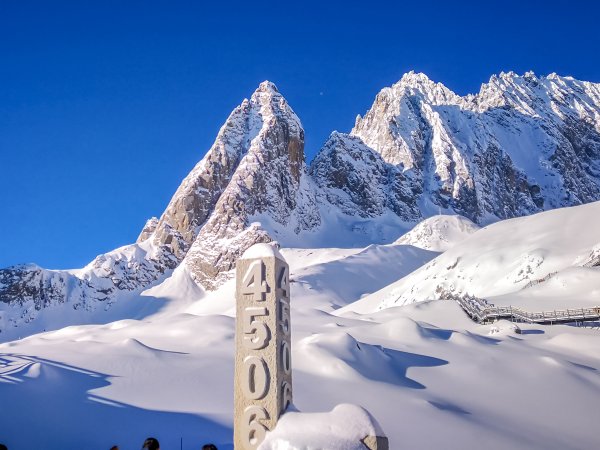Jade Dragon Snow Mountain
Jade Dragon Snow Mountain, a shining jewel of the city of Lijiang in Yunnan Province, is located approximately 15 kilometers north of Lijiang. It is the closest mountain range to the equator in the northern hemisphere, and remains covered in snow all year round. Although it is called "snow mountain", it is not just a white landscape; It has many impressive features. Many friends wonder if there is snow in Jade Dragon Snow Mountain in June. The answer is yes, there is snow on Jade Dragon Snow Mountain in June. Although the snowy landscape in June is not as abundant as in winter, it is still visible.
First, let's take a look at the main features of this snowy mountain. The Jade Dragon Snow Mountain has a length of 75 kilometers and is made up of 13 peaks, looking like a powerful dragon flying in the sky, hence its name "Yulong" (Jade Dragon). The main peak, Shanzidou, has an altitude of 5,596 meters and is covered in snow all year round, with the snow line located between 4,800 and 5,000 meters. Here is also the closest temperate oceanic glacier to the equator on the Eurasian continent, you can imagine the stunning beauty of the landscape! In addition to the stunning natural landscapes, Jade Dragon Snow Mountain also has rich cultural content. In the Naxi language, the Jade Dragon Snow Mountain is called "Eulu", which means "Sky Mountain". It is the sacred mountain of the Naxi people and is considered the incarnation of the protective god. The rock composition is mainly limestone and basalt, with a marked contrast between black and white, so it is also known as the "Black and White Snow Mountain". This land is closely linked to the Naxi people and is home to a rich ethnic culture.
Now, let's learn more about the climate and climatic characteristics of Jade Dragon Snow Mountain. Jade Dragon Snow Mountain is located on the southeastern edge of the Tibetan Plateau, under the influence of the westerly wind circulation, southwest monsoon and southeast monsoon. The climate in this region is divided into dry season and wet season. The dry season runs from November to April of the following year, mainly dominated by the southern branch of the westerly wind circulation and the winter monsoon of the Tibetan Plateau, being very dry and with little precipitation. The wet season runs from May to October, mainly dominated by the southwest and southeast monsoon, and precipitation accounts for more than 90% of the annual rainfall. This climatic feature causes an uneven distribution of rainfall and moderate changes in temperature, without a distinctive summer. Another factor that influences the climate of Jade Dragon Snow Mountain is the variation in altitude. Due to the large altitude difference from the valley to the summit, Jade Dragon Snow Mountain features multiple vertical climate zones. From the valley to the summit, you can find warm, hot and humid, temperate, subarctic and cold climates, respectively. As altitude increases, the average temperature decreases approximately 0.86℃ for every 100 meters of ascent. This varied range of climates allows you to experience different climate landscapes in the same mountain range, adding fun to exploration.
The attractive natural landscape of Jade Dragon Snow Mountain attracts more and more tourists. Thanks to its unique natural beauty and rich cultural heritage, Jade Dragon Snow Mountain has been designated as a category 5A tourist destination in China. In 2001, it was evaluated as a category 4A tourist destination and, in 2007, it was honored as one of the country's first category 5A tourist destinations. When visiting Jade Dragon Snow Mountain, you can enjoy stunning landscapes. From the base of the mountain, looking up, the thirteen snow-capped peaks are lined up like a giant dragon in the sky, majestic and grand. Under the sunlight, the snow on the mountain shines with silver light, like a beautiful painting. If you have the courage, you can also climb the main peak, Shanzidou, and experience the magnificence of being on top of the world. Furthermore, the surrounding areas of Jade Dragon Snow Mountain, such as Tiger Leaping Gorge and Jade Lake, have their own unique charm, leaving visitors with unforgettable memories.
In addition to the landscapes, the Jade Dragon Snow Mountain also has a rich cultural heritage. The Naxi consider this mountain sacred and believe that the protective god "Sanduo" resides here. The area also features the unique traditions of the Naxi people, with their dances, music and legends that reflect their love and reverence for this land. You can also learn about their traditional crafts, such as colorful handmade fabrics and wood carvings, appreciating the unique charm of the Naxi people. Jade Dragon Snow Mountain is not only a tourist destination, but also a nature reserve. In 1984, the Jade Dragon Snow Mountain Provincial Nature Reserve in Yunnan was established to protect this pure land and preserve its beauty for future generations. The reserve covers a wide area and protects a rich diversity of flora and fauna. Here, you can see rare wild animals, such as golden monkeys and snow leopards, and enjoy a variety of plants, such as alpine rhododendrons and rock orchids. The rich biodiversity of this area is truly impressive.
Jade Dragon Snow Mountain is an exceptional destination that combines natural landscapes, cultural heritage and ecological conservation. By visiting this place, you can admire the majestic beauty of the mountains, experience the traditions of the Naxi people and explore the mysteries of nature. At the same time, it is important to protect this beautiful land so that its charm continues to attract more people to discover and enjoy Jade Dragon Snow Mountain.


















